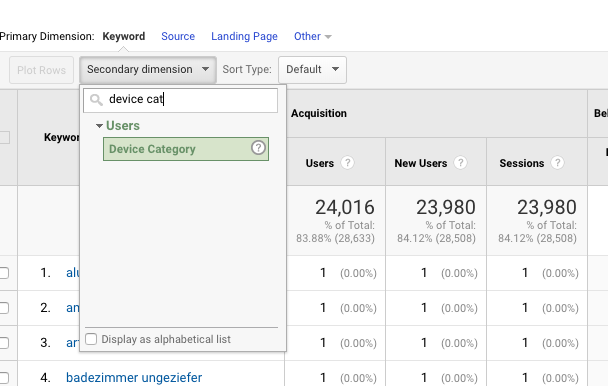Transform Your Analytics Approach With Secondary Dimension in Google Analytics
By incorporating additional dimensions into data analysis, a new layer of understandings arises, losing light on complex customer habits and communications. The tactical application of additional measurements holds the vital to unlocking a prize trove of important details that can change exactly how services act and analyze upon their information.
Comprehending Secondary Measurements in Google Analytics
Second dimensions in Google Analytics provide added context to primary data by permitting individuals to examine metrics across a 2nd dimension, providing deeper understandings into customer behavior and communications on a site. Secondary Dimension in Google Analytics. While primary dimensions give fundamental data points such as pageviews, bounce price, and session period, second dimensions use a more in-depth view by segmenting the primary information further. This segmentation allows users to examine metrics in mix with one more dimension, such as traffic resources, demographics, or individual habits
Benefits of Utilizing Secondary Measurements
Utilizing second dimensions in Google Analytics uses a critical benefit by enhancing the depth of evaluation and providing an extra detailed understanding of individual interactions and habits on a website. By including second measurements, analysts can get valuable understandings into the efficiency of certain sections or variables within their data. This allows a much more in-depth assessment of user habits past surface-level metrics, permitting a deeper expedition of the factors affecting user involvement and conversions.

Just How to Carry Out Secondary Dimensions
When including secondary dimensions in Google Analytics, one crucial step is to select the relevant metrics and measurements to improve the analysis procedure. Clicking on this switch will open a drop-down food selection listing various dimensions that can be included to your key measurement for deeper insights.
After picking the ideal second dimension, such as 'Source/Medium' or 'Gadget Group,' Google Analytics will show the data in an extra in-depth style, permitting you to cross-analyze different aspects of user actions. Bear in mind to experiment with different mixes of secondary and key measurements to uncover beneficial patterns and trends that can inform your advertising and marketing approaches. By carrying out additional measurements thoughtfully, you can gain a much more extensive understanding of your site or application efficiency and make data-driven decisions to maximize your electronic presence.
Studying Information With Secondary Dimensions
Boost your data analysis in Google Analytics by including secondary measurements to delve much deeper into user actions patterns and maximize your electronic advertising approaches properly - Secondary Dimension in Google Analytics. By including secondary dimensions to your main information, you can get useful insights that can aid you make informed choices regarding your site or app performance
Evaluating data with second dimensions enables you to sector your primary information even more, supplying an extra detailed view of individual interactions. Incorporating the main measurement of 'source/medium' with an important site additional measurement like 'touchdown page' can reveal which particular pages are driving website traffic from different sources. This info can be instrumental in refining your content approach or optimizing your advertising campaigns to boost conversions.
In addition, using second dimensions enables you to determine relationships in between different metrics, helping you recognize the influence of various aspects on individual behavior. Whether it's assessing demographics along with individual interaction metrics or tool classifications with conversion rates, additional dimensions equip you to uncover hidden patterns and patterns that can lead your advertising and marketing initiatives.
Enhancing Efficiency With Additional Dimensions
To improve the effectiveness of data analysis and decision-making in Google Analytics, incorporating additional dimensions is crucial to enhancing efficiency metrics and obtaining deeper insights into individual habits patterns. By using secondary measurements, analysts can dive past surface-level data and uncover beneficial relationships that may otherwise go undetected. This optimization method enables organizations to customize their marketing efforts better, determine areas for enhancement in site use, and their website improve overall customer experience.
Secondary measurements provide an even more thorough sight of customer communications by giving additional context to primary data metrics. Coupling the primary dimension of 'touchdown web page' with a second dimension like 'gadget classification' can disclose whether certain gadgets are extra most likely to drive involvement on details touchdown pages. This understanding can inform receptive style improvements or targeted advertising methods to increase performance.
Conclusion
In verdict, the integration of secondary measurements in Google Analytics supplies businesses with a powerful device to enhance their analytics strategy. Secondary Dimension in Google Analytics. By diving deeper right into customer habits and communications, marketers can discover important understandings that can drive efficiency optimization and improve the general customer experience. Leveraging second measurements enables for an extra thorough evaluation of information, bring about more informed decision-making and customized marketing efforts
Secondary measurements in Google Analytics provide additional context to main data by allowing individuals to evaluate metrics throughout a second dimension, supplying deeper insights into customer habits and communications on a web site. While main measurements provide navigate here essential data points such as pageviews, bounce price, and session period, additional dimensions use an even more in-depth view by segmenting the primary data further.One of the essential advantages of using second dimensions is the capacity to discover connections and patterns that might not be promptly obvious when examining data with key dimensions alone.When integrating secondary measurements in Google Analytics, one essential step is to choose the relevant metrics and measurements to improve the analysis process. Coupling the main dimension of 'touchdown page' with a secondary dimension like 'device group' can disclose whether certain gadgets are more likely to drive engagement on details touchdown pages.